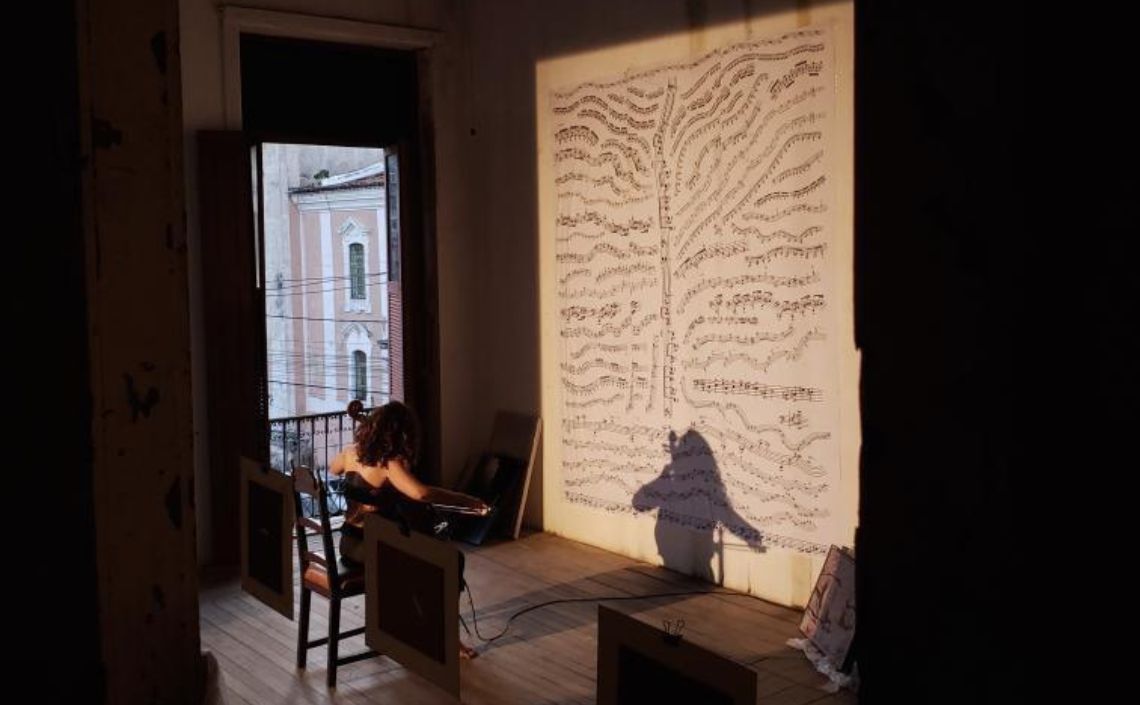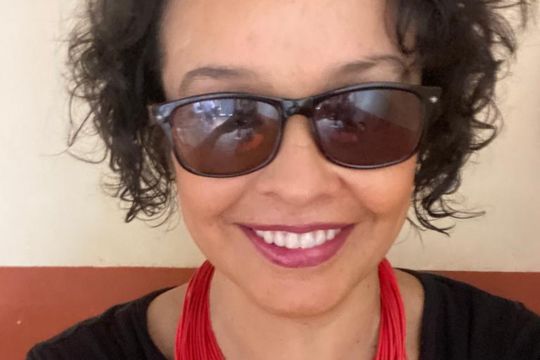Set in the heart of the Amazon Rainforest, Terruá Pará is a musical, audiovisual tribute to the lush environs of the landscape, presenting its diverse musical scenes set across the state of Pará. Directed by screenwriter and director Jorane Castro, who herself was born in the region, the film recreates this spirit of the mighty Amazon, with each part unveiling the universe where the music of Pará originated. We have caught up with Jorane to discuss her film as well as the new project she has been working on, a tribute to one of the great composers of Amazonian music, Mestre Cupijó, a seminal figure from the 1970s to the end of the 20th century.
- 23-27 OCT 2024
- Manchester, UK
Terruá Pará
Interview with Jorane Castro
22 March 2024 by Lucia Udvardyova
Your film, Terruá Pará, is set in the state of Pará in Brazil, traversed by the Amazon Rainforest. You come from this area yourself. Why did you decide to capture the music scene of the region?
Terruá Pará proposes a vision in which culture and nature merge into one. In other words, the idea of the film is to show that man is totally at one with nature. This dichotomy that we always create between humanity not being part of nature - we tried to show another point of view with this film. So, the idea was to show how Amazonian music emanates from all these places, where it pulses and lives. When you look at the world from here in the Amazon, you see humanity integrated into this universe, and you can see that very clearly.
The film itself is composed of various mini-chapters that not only introduce the musicians, but also the beautiful landscape. How did you structure the film itself? What was the interplay between the various environments and the musicians?
I've been following the Amazonian music scene here in Pará for some time now. For this reason, I know what the traditions are and their origins, what's emerging... I'm always aware of this movement, which is diverse and powerful. When I came up with the idea of making a movie on this subject, I already had this background of research and experience. So, the challenge was audacious, but I realized that it would be a very exciting audiovisual experience.
The conception of the scenes was inspired by the idea of "terroir" - terruá in Brazilian Portuguese - practising the French concept that Pará's music is unique because it comes from this unique place. I also imagined that all this music came from the waters, from the forests, carried by the winds and tides. As the presence of nature in the Amazon is real, it was a way of showing the very best of our landscape and music. This was the idea that drove the process of creating the film.
There is a beautiful scene where a group of musicians play under water. Could you talk about this specific scene?
The first scene of the movie is the starting point for proposing this concept that music, but also culture as a whole, springs from natural elements. It's like an introduction and a synthesis of what the film will present next. It introduces this view within its construction of a cinematographic narrative and a musical performance. It would be the proposal of a "dive" into fluid borders, which are invisible but felt epidermically by the audience. "Trio Manari", which is the group that plays in the water, gave themselves over to the making of this scene, and the result has a lot to do with the harmony between them and, of course, their talent. It was a delight to create and then perform this scene, and it was even better because the artists and the team really gave themselves to making it happen.
How did you select the musicians and the scenes?
The music from Pará is, first and foremost, a celebration of life, interpreted with the danceable sound of the Amazon. The rhythms are almost all-party rhythms, made for joy and dancing. It was, therefore, important to make a movie that portrayed this spirit and described this dynamic universe. Thus, the film was designed to be an audiovisual experience, and to bring this musical spirit to the silver screen.
The selection of artists was defined in conjunction with the musical panorama of Pará. We started with a scene where there is only the sound of nature and the musicians' bodies, with a more organic and acoustic conception, but which gradually becomes more urban, almost ending with rap with street dance and so on. It was important to show this diversity, and closeness between the different sonorities because that's how it happens.
The film had a very detailed script that defined what would happen in each sequence. The locations of the scenes were defined according to the musical universe of each artist, but the songs played were decided in agreement with the artists and the film's musical director, Assis Figueiredo.
Most of the footage comes from nature, the scenic environs of the Amazon River and the Rainforest. Towards the end, we enter the city of Belém, which feels like an antithesis to the soothing, tranquil environs of the natural habitats we saw before. Was this a conscious decision?
The progressive approach to the urban side of the region is as if the city of Belém were surrounded by all these sounds. The film first shows the city in the distance and gradually arrives in Belém. Here in Pará, we have a large presence of electronic music fused with traditional rhythms, like tecnobrega, for example. The great masters of popular music, who were successful in the 1960s and 1970s, used to build their own electric instruments. They introduced electric or electronic instruments to traditional rhythms, such as guitar, bass, saxophone, brass section, and electric keyboard. It's a tradition that has a relationship with pop culture, but also a dynamic and powerful music that appropriates traditional rhythms to create new styles of music.
So, Belém's presence in the film represents this curiosity for the new, which is the culture of the people of the Amazon. That's why we have hip hop, street dance, guitarrada, as well as classic contemporary composition, all of which together reproduce the creative and effervescent melting pot of this region. The film's mission was to touch on all these elements, which draw on traditional sources, but are linked in contemporary times.
You have an extensive career in cinematography - as a screenwriter, producer, director and teacher. Does making a music documentary differ from other genres in your experience? If so, then in what way?
For me, making a music documentary is a great pleasure because music is a narrative structure, and in this case, it becomes a narrative structure parallel to the cinematographic one. In other words, through the music itself, the lyrics, the harmony, the universe of the film already has all this sophistication. And with this information, you have an inspiring narrative. And reflecting narrative structure, in all its complexity, is a cinematographic exercise that gives me the feeling that the construction of the film project is in constant movement. An artistic universe that presents itself to be honed and transformed into another language organically.
I've already had the opportunity to make films about music and discover new musical universes in countries such as Mali or Morocco, or even on islands in the Indian Ocean, such as the Comoros or the island of Réunion. These are places with a strong musical tradition, a place of cultural mixtures, which is why they are very exciting. These were very rich experiences, which helped me to think about the films I make today in the Amazon. Here, I film elements of my cultural belonging; in these other projects, they were experiences that led me to discover the unknown. These two different processes have helped me to develop a look that is curious about learning. And I'm still very interested in these artistic encounters with musicians who still stimulate and teach me.
What are your current projects?
Interestingly, I'm working on a music documentary project again. In fact, it's a more complex project, which has gone beyond the limits of cinema. It's a tribute to one of the great composers of Amazonian music, Mestre Cupijó (1936-2012). He was an important figure from the 1970s to the end of the 20th century who left behind an extensive work which is much appreciated in Brazil.
Initially, the project was just a documentary. However, as Mestre Cupijó e seu Ritmo developed, we realized that the film led to the creation of a band dedicated to playing Mestre's hits. Made up of ten instrumentalists from the new generation of Pará musicians, in February 2024, they released their first studio album, entitled "Baile do Mestre Cupijó". In April 2024, the band will publish a full concert recorded in a theatre on digital platforms. The band's proposal is to make a contemporary reinterpretation of Mestre Cupijó's compositions. It has been very successful in the shows it has performed in Pará and elsewhere in Brazil. The documentary will also be released on platforms and in cinemas in May 2024, in Brazilian capitals.
This project, which is much more complex than just a movie, led me to a new experience: seeing a documentary bear fruit, which in this case is a band, "Baile do Mestre Cupijó". There really is no limit to the partnership between music and cinema. With all this content, the music of Mestre Cupijó can continue to be heard thanks to "Baile do Mestre Cupijó". This initiative will allow this traditional Amazonian music to be appreciated by new audiences where it has never been played before. So today, we are working to give visibility to Mestre Cupijó and his cultural heritage.





